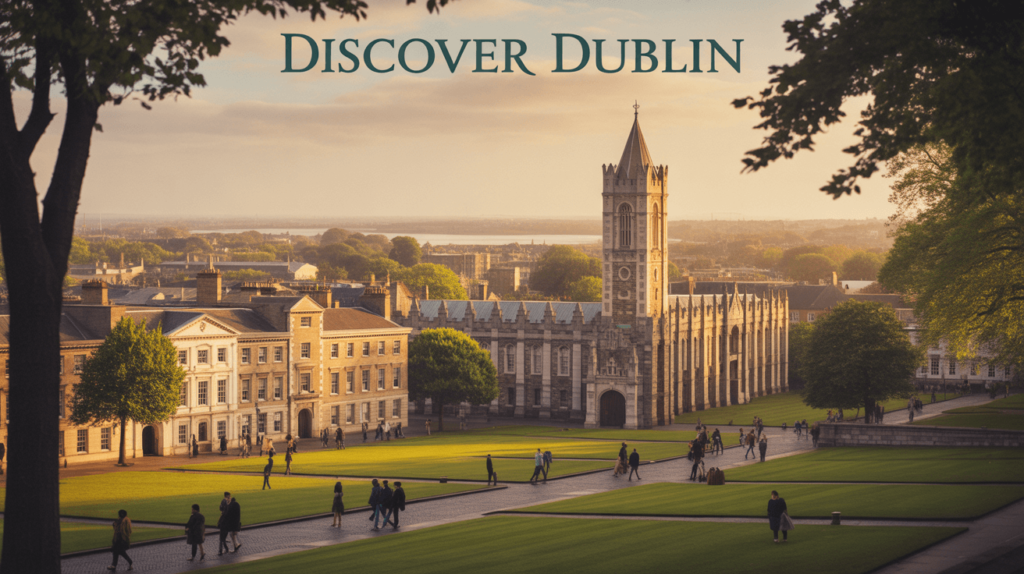Traveling to Dublin, the vibrant capital of Ireland, is a dream for many. It’s a city that blends old-world charm with modern life—a place where medieval castles stand alongside bustling pubs, where literary history is celebrated as much as Guinness, and where warm hospitality greets you at every turn. In today’s world, where travelers are increasingly seeking experiences that combine culture, history, and authenticity, Dublin continues to rise as one of Europe’s most beloved destinations.
As someone who has spent time in Dublin, walking its cobblestone streets, exploring its cozy cafes, and chatting with locals, I can confidently say that the city offers far more than meets the eye. Whether you’re planning a short weekend trip, a cultural immersion, or using Dublin as a gateway to the rest of Ireland, this guide will help you navigate your journey with practical advice, insider hacks, and research-backed information.
Why Dublin Matters as a Travel Destination Today
Dublin attracts millions of visitors annually. According to Fáilte Ireland (the National Tourism Development Authority), over 8 million overseas visitors came to Ireland in 2023, with Dublin serving as the primary entry point. Its international airport is one of the busiest in Europe, making it not just a hub for Irish tourism, but also a cultural landmark in itself.
What makes Dublin so special today is its ability to cater to every type of traveler. For the history buff, there are Viking and medieval ruins. For the foodie, world-class restaurants are popping up alongside traditional pubs. For the wanderer, Dublin’s compact layout makes it walkable and easily accessible. And for those seeking warmth, the Irish culture of friendliness and storytelling is unmatched.
Getting to Dublin
By Air
Dublin Airport (DUB) is the main gateway, with direct flights from North America, Europe, and even the Middle East. Budget airlines such as Ryanair and Aer Lingus also make it affordable to reach Dublin from almost anywhere in Europe.
By Ferry
For those coming from the UK or France, ferries to Dublin Port or Dún Laoghaire are another option. While slower, it can be a scenic and cost-effective way to travel.
From the Airport to the City
The airport is just 10 km north of the city center. The Aircoach and Dublin Express buses are popular, running frequently and costing around €7–€8. Taxis and rideshares are also available, but cost closer to €30–€40.
Where to Stay in Dublin
Accommodation in Dublin can be pricey, but options exist for all budgets:
- Budget: Hostels like Generator Dublin and Abbey Court are centrally located and popular among backpackers.
- Mid-Range: Boutique hotels such as The Morgan Hotel or The Dean Dublin offer stylish stays without breaking the bank.
- Luxury: The Shelbourne Dublin, a five-star historic hotel, is perfect if you want elegance and Irish tradition.
Tip: Book early, especially during peak tourist months (June–September) and around St. Patrick’s Day in March.
Best Time to Visit Dublin
- Spring (March–May): Mild weather, blooming parks, fewer tourists.
- Summer (June–August): Festivals, long daylight hours, but crowds and higher prices.
- Autumn (September–November): Cooler weather, fewer crowds, lower accommodation costs.
- Winter (December–February): Quiet, festive atmosphere around Christmas, shorter days, and chillier weather.
From personal experience, I found late spring (April–May) to be the sweet spot. The weather is pleasant, pubs are lively, and you won’t face overwhelming tourist crowds.
Top Attractions in Dublin
1. Trinity College & The Book of Kells
This historic university houses the famous 9th-century manuscript, The Book of Kells. The Long Room of the Old Library is a sight you won’t forget—it looks like something out of Harry Potter.
2. Dublin Castle
Built in the 13th century, this castle blends medieval, Georgian, and modern architecture. It’s an excellent introduction to Ireland’s complex history.
3. Guinness Storehouse
Dublin’s most popular tourist attraction. Even if you’re not a big beer drinker, the interactive tour and rooftop Gravity Bar (with panoramic views) are worth the visit.
4. Temple Bar District
Famous for its pubs, cobblestone streets, and nightlife. While some locals consider it touristy, it’s still worth experiencing for the energy and atmosphere.
5. Kilmainham Gaol
A former prison turned museum, this site offers a powerful look at Ireland’s struggle for independence.
6. St. Patrick’s Cathedral & Christ Church Cathedral
Both are stunning examples of medieval architecture and central to Dublin’s spiritual history.
7. Phoenix Park
One of Europe’s largest enclosed parks—perfect for picnics, cycling, or spotting wild deer.
Hidden Gems in Dublin
While the major attractions are popular, I found some hidden gems worth exploring:
- Marsh’s Library: A 300-year-old library with ancient manuscripts.
- The Little Museum of Dublin: A quirky and intimate look at Dublin’s social history.
- Howth: A seaside village just 30 minutes away by train, perfect for fresh seafood and coastal hikes.
Food & Drink in Dublin
Irish food has evolved far beyond the traditional stereotype of potatoes and stew. Today, Dublin is a foodie haven:
- Traditional Dishes: Irish stew, coddle, boxty (potato pancake), and soda bread.
- Seafood: Oysters, mussels, and fresh Atlantic fish are widely available.
- Pubs: Try a pint of Guinness (locals say it tastes better in Dublin). Many pubs also serve hearty meals at affordable prices.
Recommended spots:
- The Brazen Head (Ireland’s oldest pub, dating back to 1198)
- O’Donoghue’s (famous for traditional live music)
- Fallon & Byrne (for gourmet dining)
Getting Around Dublin
Dublin is compact, making walking the best way to explore. However, public transport is reliable and affordable:
- DART (Dublin Area Rapid Transit): Great for coastal towns like Howth and Dalkey.
- Luas (tram system): Covers many city neighborhoods.
- Dublin Bus: Wide network, though sometimes slower due to traffic.
- Leap Card: A rechargeable travel card that saves money on fares.
Tip: Skip renting a car in Dublin city. Parking is expensive and traffic is heavy. Save car rentals for exploring rural Ireland.
Budgeting for Dublin
Dublin is known for being more expensive than other European capitals. On average:
- Hostel: €25–€45 per night
- Hotel: €120–€250 per night
- Pub meal: €12–€20
- Restaurant meal: €20–€40
- Pint of Guinness: €6–€7
Money-Saving Hacks:
- Buy a Dublin Pass, which includes entry to 35+ attractions.
- Eat in pubs or grab sandwiches from local delis instead of dining in tourist-heavy restaurants.
- Walk as much as possible—many attractions are close together.
Safety & Practical Tips
- Safety: Dublin is generally safe, but like any major city, pickpocketing can happen in crowded areas like Temple Bar.
- Weather: It’s unpredictable—always carry a waterproof jacket and umbrella.
- Cultural Etiquette: The Irish are friendly, but avoid heated political discussions unless you’re well-informed.
- Language: English is the primary language, though Irish (Gaelic) is also an official language. You’ll see bilingual signs.
Suggested Itinerary
Day 1: Trinity College, Dublin Castle, Temple Bar nightlife
Day 2: Kilmainham Gaol, Guinness Storehouse, Phoenix Park
Day 3: Christ Church Cathedral, St. Patrick’s Cathedral, day trip to Howth
Final Thoughts
Dublin is more than just a stopover—it’s a city with soul. From its literary legends like James Joyce and Oscar Wilde to its cozy pubs and dynamic street life, Dublin has an energy that stays with you long after your trip ends.
For me, what stood out most wasn’t just the landmarks but the people. I remember sitting in a pub in Temple Bar, chatting with a local who insisted on teaching me a bit of Irish. That friendliness, that eagerness to share stories, is what makes Dublin truly unique.
If you’re planning a trip, embrace the mix of history and modernity, indulge in the food and drink, and most importantly, take time to slow down and enjoy the warmth of the Irish spirit.
👉 Have you been to Dublin or are you planning a trip soon? Share your experiences or questions—I’d love to hear your thoughts!

Hi, I’m Tanvir, the founder and author of Explore Ireland Now. With a deep love for Ireland and its rich culture, history, and landscapes, I created this site to share everything that makes this beautiful country worth exploring. Whether you’re a local looking for hidden gems or a traveler planning your next adventure, I provide insightful guides, tips, and recommendations to help you experience Ireland to the fullest.
From stunning landscapes to vibrant cities and quaint villages, Ireland is full of wonders waiting to be discovered. Through my personal experiences and research, I aim to bring you the most up-to-date information and inspiration for your journey.
Thank you for visiting Explore Ireland Now—I hope my content helps you uncover all that this incredible country has to offer! If you have any questions or need travel advice, feel free to reach out.



